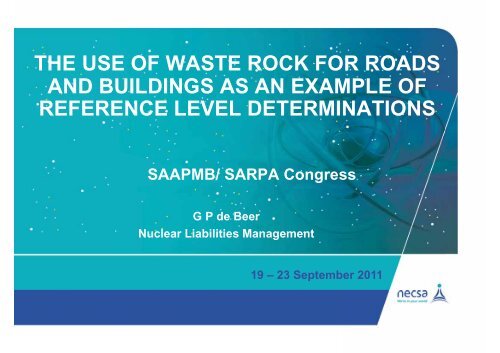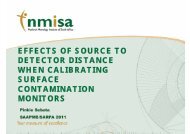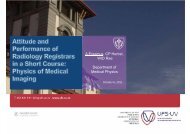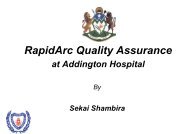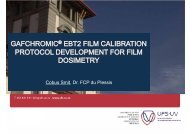THE USE OF WASTE ROCK FOR ROADS AND BUILDINGS AS AN ...
THE USE OF WASTE ROCK FOR ROADS AND BUILDINGS AS AN ...
THE USE OF WASTE ROCK FOR ROADS AND BUILDINGS AS AN ...
You also want an ePaper? Increase the reach of your titles
YUMPU automatically turns print PDFs into web optimized ePapers that Google loves.
<strong>THE</strong> <strong>USE</strong> <strong>OF</strong> <strong>W<strong>AS</strong>TE</strong> <strong>ROCK</strong> <strong>FOR</strong> <strong>ROADS</strong><br />
<strong><strong>AN</strong>D</strong> <strong>BUILDINGS</strong> <strong>AS</strong> <strong>AN</strong> EXAMPLE <strong>OF</strong><br />
REFERENCE LEVEL DETERMINATIONS<br />
SAAPMB/ SARPA Congress<br />
G P de Beer<br />
Nuclear Liabilities Management<br />
19 – 23 September 2011
Introduction<br />
• The European Union introduced Reference Levels to harmonise the<br />
approach to determine when work activities with materials<br />
containing enhance levels of NORM need radiological controls.<br />
• Reference Levels were derived and used to determine the degree of<br />
regulatory control based on annual effective dose criteria of 1 mSv,<br />
6 mSv, 20 mSv and 50 mSv.<br />
• Locally the need arose from efforts to harmonise and reduce<br />
analysis efforts within the NORM industry.<br />
• The purpose of this presentation is to indicate how Reference<br />
Levels could be used in generic assessments within the NORM<br />
industry for the purpose above.<br />
• As an example Reference Levels will be determined for the use of<br />
waste rock for the construction and use of roads and buildings.
Scope of Presentation<br />
• A system description first describes the various operations and<br />
actions through which workers and members of the public could be<br />
exposed as a result of using waste rock for building and roads.<br />
• Based on the system description above, scenarios are developed for<br />
worker and public exposure.<br />
• Next the mathematical formulations are presented for assessing<br />
relations between the nuclide concentrations and the worker and<br />
public doses.<br />
• The formulations above are then used to derive Reference Levels for<br />
worker and public exposure.
Actions at the Mine<br />
• Actions at the mine relate to the crushing and screening of waste rock<br />
into different sizes at the mine. It considers:<br />
– A front-end loader (FEL) driver feeding the crusher and screen and also<br />
loading the screened waste rock onto transport trucks.<br />
– Two operators attending to the operation of the crusher and screen.<br />
– Truck drivers who will carry the screened waste rock by large trailer-type<br />
road trucks to the construction sites where it will be unloaded at different<br />
locations along the road or building construction sites as per the required<br />
amounts.
Actions at the Road Construction Site<br />
• It is assumed that the waste rock is only used for the tarmac layers<br />
of the road as per the following operations.<br />
• The waste rock will be loaded by a front-end loader into an asphalt<br />
preparer and tarmac applier.<br />
• The tarmac applier will lay a 7 cm thick tarmac layer on the<br />
compacted and prepared road surface sprayed with a layer of tar.<br />
• After some roller compaction and a further tar spraying, a thin layer<br />
of finer asphalt-containing waste rock is applied to finish the<br />
surface.<br />
• It will be assumed that the same workers consisting of the drivers of<br />
the tarmac applier, roller, sprayer and about four labourers are<br />
exposed during these operations.<br />
• Road painters will finally mark the road with dashed, solid or other<br />
lines.
Actions at the Building Construction Site<br />
• It is assumed that the waste rock will be delivered to a concrete mixing<br />
site, where it will be loaded by a front-end loader into a concrete mixer,<br />
overlooked by an operator.<br />
• After mixing the concrete will again be transported to the building<br />
construction sites.<br />
• It is assumed that on the construction site the concrete is poured into slabs<br />
around 10 cm thick, involving 5 construction workers, exposed to external<br />
radiation from a slab of concrete.
Possible Road and Building Users<br />
• Road Users<br />
– Road users will consist of regular but selective users, which should represent a<br />
conservative public scenario.<br />
– Based on work performed by the IAEA to determine exemption levels for<br />
radioactive scrap metal, a taxi driver will be used to assess public reference<br />
levels for road users.<br />
• Building Users<br />
– Two types of building users will be considered.<br />
– The first will consist of office workers exposed to 2000 h/a to the floor slab of<br />
the building.<br />
– The second will consist of a residential users exposed to the floor slab of a<br />
residence for 7000 h/a.
Mine Site Exposure Scenarios<br />
• Crusher/Screen Operators and FEL Driver (2000 h/a)<br />
– Assumed to be exposed to external gamma radiation from an infinite slab of<br />
waste rock at average distances of 1 m and 2 m respectively.<br />
– Also assumed to inhale dust generated through the loading, crushing and<br />
screening operations at an average gravimetric dust load of 1 mg/m 3 (double<br />
the inhalable concentration assumed by the NEA for road construction<br />
operations but similar to the value assumed by the IAEA for slag workers).<br />
• Waste Rock Transporter (1000 h/a because one way only)<br />
– Transport of the waste rock to the clients included as an on-site activity.<br />
– Transporter assumed to be situated 2 metres away from a 20 tonne load of<br />
waste rock simulated as a half cylinder with a radius of 0.8 metre and length of<br />
about 10 metres (similar to the scenario assumed by the IAEA for truck drivers<br />
transporting scrap).<br />
– Transporter only be exposed to dust during loading and unloading operations<br />
(less than 10 % of working period), which is similar to continuous exposure to a<br />
gravimetric dust load of 100 μg/m 3 .
Road Construction Exposure Scenarios<br />
• Tarmac Applier<br />
– Assumed to be exposed to the load of waste rock and gravel aggregate mixed<br />
with asphalt; hence only external gamma radiation to be considered. Except for<br />
the reduced time of 500 h/a external exposure conditions similar to those for<br />
the waste rock transporter are assumed.<br />
• Roller Driver<br />
– Situated about 2 metres above the tarmac surface but his exposure period in<br />
this location will be restricted to 100 h/a.<br />
• Tarmac Applier Attendants<br />
• Exposed to very similar conditions as the workers at the mine but:<br />
• To external gamma radiation from the 7.0 cm to 7.5 cm thick tarmac layer<br />
• If any to very low dust load not exceeding 0.1 mg/m 3 .<br />
• Their exposure period per annum will be limited to 500 h/a.<br />
• For the road painters their exposure period will be limited to only 100 h/a.
Building Construction Exposure Scenarios<br />
• FEL Driver at the concrete mixer<br />
– Exposed to the load of gravel aggregate to be mixed with cement.<br />
– Exposure similar to FEL driver at mine but for reduced time of 500 h/a.<br />
• Driver of the mixed concrete truck<br />
– Exposed only to external gamma radiation from the concrete mix.<br />
– Exposure similar to Tarmac Applier in the road construction scenario.<br />
• Builders<br />
– Exposed to the concrete during the pouring of the slabs and subsequently<br />
during building construction.<br />
– Exposure conditions are similar to those of the Tarmac Applier Attendants in<br />
the road construction scenario.<br />
– Concrete is, however, assumed to be 10 cm thick and diluted with sand and<br />
cement to contain 60 % waste rock in the concrete mixture.
Road and Building User Scenarios<br />
• Road User<br />
– Assumed that a taxi driver will be on the road for 70 % of the available 2000 h/<br />
a. Of this he is assumed to drive 50 % (700 h/a) on roads constructed from<br />
waste rock.<br />
– Assumed to be 1 metre away from the radioactive tarmac surface.<br />
• Building User<br />
– Assumed that all building users are exposed to gamma radiation from the slab<br />
of concrete at the same dose rate as the builders, but for exposure periods of<br />
2000 and 7000 h/a for office workers and residents respectively and to 10 cm<br />
and 7.5 cm thick concrete slabs respectively.<br />
– Indoor radon concentrations are extrapolated from a radon concentration of 6.3<br />
Bq.m -3 and a dose of 80 Sv.a -1 determined for office buildings and rooms for<br />
waste rock with an average U-238 and Ra-226 concentration of 0.015 Bq.g -1<br />
and an air exchange rate of 1 h -1 .<br />
– The assessed concentrations will be evaluated against ICRP recommended<br />
action levels.
Mathematical Formulation: External Dose<br />
• External gamma dose<br />
• Where<br />
• T = Exposure period [h.a-1 ]<br />
• SA = Specific activity of U-238 or Th-232 in the waste rock [Bq.g-1 ]<br />
• L = Dilution factor<br />
• DCExt = External DC for uranium or thorium [Sv.h-1 per Bq.g-1 ]<br />
• A dilution factor of 1 has been assumed for exposure to waste rock and 0.6 for<br />
exposure to building concrete.<br />
• External dose coefficients for the uranium and thorium series with all nuclides in<br />
secular equilibrium have been calculated with the MicroShield software for the<br />
various source geometries defined in the scenarios.
MicroShield External Dose Coefficients
Mathematical Formulation: Inhalation Dose<br />
• Inhalation Dose<br />
– Where<br />
– T = Exposure period [h.a-1 ]<br />
– SA = Specific activity of U-238 or Th-232 in the waste rock [Bq.g-1 ]<br />
– M = Gravimetric airborne activity [mg.m-3 ]<br />
– BR = Breathing rate of exposed persons [m3 .h-1 ]<br />
– DCInh = Inhalation DC for uranium or thorium [Sv.Bq-1 ]<br />
– Inhalation dose coefficients for the uranium and thorium series with all nuclides<br />
in secular equilibrium were calculated from nuclide coefficients selected from<br />
the IAEA BSS for dust with an AMAD of 5 μm.
Inhalation Dose Coefficients
Radon Dose and Action Levels<br />
• The radon exhalation rate and radon concentration in office<br />
and residential buildings is extrapolated from a radon<br />
concentration of 6.3 Bq.m-3 and an annual dose of 80<br />
Sv.a-1 determined experimentally for similar waste rock<br />
with an average Ra-226 concentration (assumed to be in<br />
secular equilibrium with U-238) of 0.015 Bq.g-1 .<br />
• An action level of 200 Bq.m-3 or annual dose of 3 mSv.a-1 will<br />
hence relate to a nuclide concentration of 0.5 Bq.g-1 .<br />
• This is the same as the exemption level of 0.5 Bq.g-1 and all<br />
exempted waste rock should hence comply with this<br />
criterion.
Assessment<br />
• Pathway- and series related effective doses were first calculated at<br />
equilibrium nuclide concentrations of 1 Bq/g for each nuclide in each of<br />
the U-series and Th-series.<br />
• Calculations were performed by inserting the mathematical formulations<br />
and dose coefficients in spreadsheets together with other scenario<br />
parameters to obtain doses related to 1 Bq/g nuclide concentration.<br />
• Multiplication factors were obtained to adjust the doses from 1 Bq/g to 1<br />
mSv/a.<br />
• The nuclide concentrations were multiplied with these factors in repeat<br />
calculations to present equilibrium Reference Concentrations for<br />
equilibrium nuclide conditions that would present a dose of 1 mSv/a.<br />
• These could be performed separately for each pathway or as total dose<br />
via both the external exposure and inhalation pathways.
Typical On-site Scenario Results
Typical Building Scenario Results
Typical Road Scenario Results
Thank You!!!


